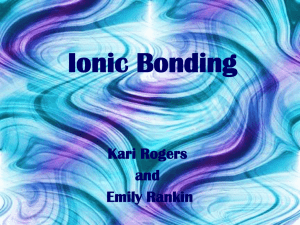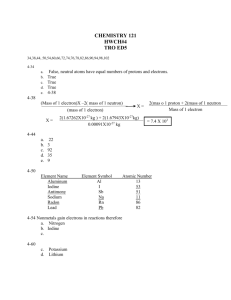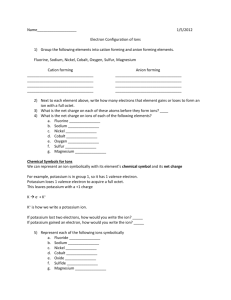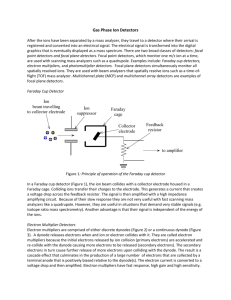Part B. Self-sustained gas discharge
advertisement
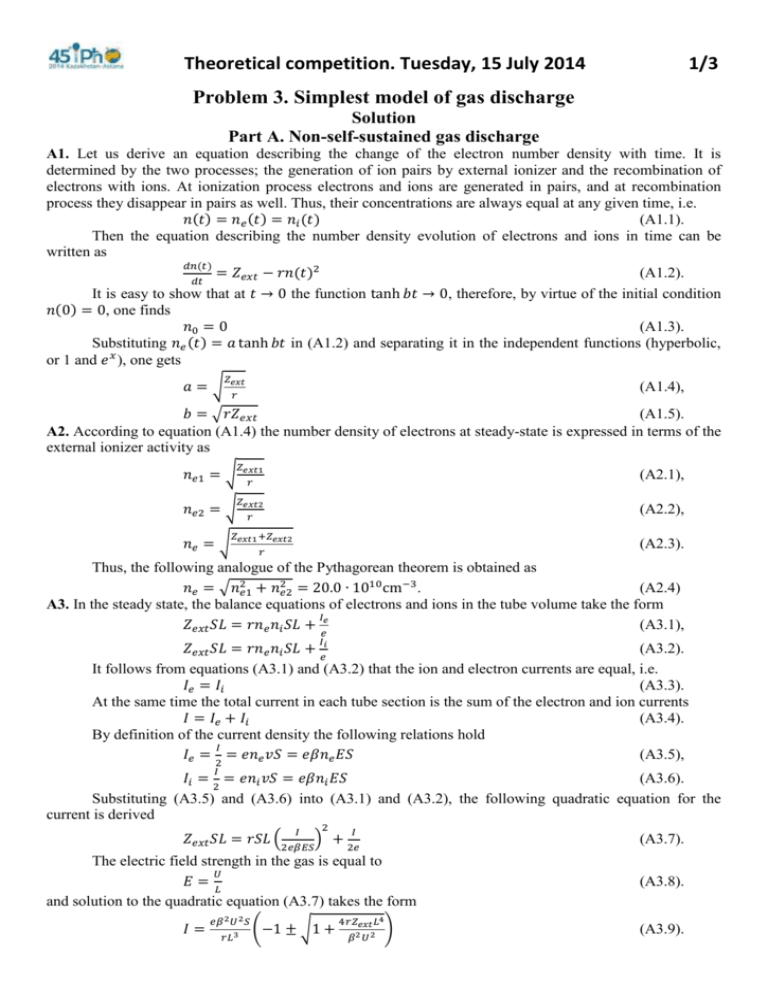
Theoretical competition. Tuesday, 15 July 2014 1/3 Problem 3. Simplest model of gas discharge Solution Part А. Non-self-sustained gas discharge A1. Let us derive an equation describing the change of the electron number density with time. It is determined by the two processes; the generation of ion pairs by external ionizer and the recombination of electrons with ions. At ionization process electrons and ions are generated in pairs, and at recombination process they disappear in pairs as well. Thus, their concentrations are always equal at any given time, i.e. 𝑛(𝑡) = 𝑛𝑒 (𝑡) = 𝑛𝑖 (𝑡) (A1.1). Then the equation describing the number density evolution of electrons and ions in time can be written as 𝑑𝑛(𝑡) = 𝑍𝑒𝑥𝑡 − 𝑟𝑛(𝑡)2 (A1.2). 𝑑𝑡 It is easy to show that at 𝑡 → 0 the function tanh 𝑏𝑡 → 0, therefore, by virtue of the initial condition 𝑛(0) = 0, one finds 𝑛0 = 0 (A1.3). Substituting 𝑛𝑒 (𝑡) = 𝑎 tanh 𝑏𝑡 in (A1.2) and separating it in the independent functions (hyperbolic, or 1 and 𝑒 𝑥 ), one gets 𝑍𝑒𝑥𝑡 𝑎=√ (A1.4), 𝑟 𝑏 = √𝑟𝑍𝑒𝑥𝑡 (A1.5). A2. According to equation (A1.4) the number density of electrons at steady-state is expressed in terms of the external ionizer activity as 𝑍𝑒𝑥𝑡1 𝑛𝑒1 = √ (A2.1), 𝑟 𝑍𝑒𝑥𝑡2 𝑛𝑒2 = √ (A2.2), 𝑟 𝑍𝑒𝑥𝑡1 +𝑍𝑒𝑥𝑡2 𝑛𝑒 = √ (A2.3). 𝑟 Thus, the following analogue of the Pythagorean theorem is obtained as 2 2 𝑛𝑒 = √𝑛𝑒1 + 𝑛𝑒2 = 20.0 ∙ 1010 cm−3. (A2.4) A3. In the steady state, the balance equations of electrons and ions in the tube volume take the form 𝐼 𝑍𝑒𝑥𝑡 𝑆𝐿 = 𝑟𝑛𝑒 𝑛𝑖 𝑆𝐿 + 𝑒𝑒 (A3.1), 𝐼 𝑍𝑒𝑥𝑡 𝑆𝐿 = 𝑟𝑛𝑒 𝑛𝑖 𝑆𝐿 + 𝑒𝑖 (A3.2). It follows from equations (A3.1) and (A3.2) that the ion and electron currents are equal, i.e. 𝐼𝑒 = 𝐼𝑖 (A3.3). At the same time the total current in each tube section is the sum of the electron and ion currents 𝐼 = 𝐼𝑒 + 𝐼𝑖 (A3.4). By definition of the current density the following relations hold 𝐼 𝐼𝑒 = 2 = 𝑒𝑛𝑒 𝑣𝑆 = 𝑒𝛽𝑛𝑒 𝐸𝑆 (A3.5), 𝐼 𝐼𝑖 = 2 = 𝑒𝑛𝑖 𝑣𝑆 = 𝑒𝛽𝑛𝑖 𝐸𝑆 (A3.6). Substituting (A3.5) and (A3.6) into (A3.1) and (A3.2), the following quadratic equation for the current is derived 𝐼 2 𝐼 𝑍𝑒𝑥𝑡 𝑆𝐿 = 𝑟𝑆𝐿 (2𝑒𝛽𝐸𝑆) + 2𝑒 (A3.7). The electric field strength in the gas is equal to 𝑈 𝐸=𝐿 and solution to the quadratic equation (A3.7) takes the form 𝐼= 𝑒𝛽 2 𝑈 2 𝑆 𝑟𝐿3 (−1 ± √1 + 4𝑟𝑍𝑒𝑥𝑡 𝐿4 𝛽2 𝑈 2 ) (A3.8). (A3.9). Theoretical competition. Tuesday, 15 July 2014 2/3 It is obvious that only positive root does make sense, i.e. 𝐼= 𝑒𝛽 2 𝑈 2 𝑆 𝑟𝐿3 (√1 + 4𝑟𝑍𝑒𝑥𝑡 𝐿4 𝛽2 𝑈 2 − 1) (A3.10). A4. At low voltages (A3.10) simplifies and gives the following expression 𝑍𝑒𝑥𝑡 𝑆 𝐼 = 𝑈2𝑒𝛽√ 𝑟 𝐿 . (A4.3) which is actually the Ohm law. Using the well-known relation 𝑈 𝑅=𝐼 together with 𝐿 𝑅 = 𝜌𝑆 one gets 1 𝜌 = 2𝑒𝛽 √𝑍 (A4.1) (A4.2), 𝑟 (A4.4). 𝑒𝑥𝑡 Part B. Self-sustained gas discharge B1. Consider a gas layer located between 𝑥 and 𝑥 + 𝑑𝑥.The rate of change in the electron number inside the layer due to the electric current is given for a small time interval 𝑑𝑡 by 𝐼 (𝑥+𝑑𝑥)−𝐼 (𝑥) 1 𝑑𝐼 (𝑥) 𝑒 𝑒 𝑑𝑁𝑒𝐼 = 𝑒 = 𝑒 𝑑𝑥 𝑑𝑥𝑑𝑡. (B1.1). 𝑒 This change is due to the effect of the external ionization and the electron avalanche formation. The external ionizer creates the following number of electrons in the volume 𝑆𝑑𝑥 𝑑𝑁𝑒𝑒𝑥𝑡 = 𝑍𝑒𝑥𝑡 𝑆𝑑𝑥𝑑𝑡 (B1.2). whereas the electron avalanche produces the number of electrons found as 𝐼 (𝑥) 𝑑𝑁𝑒𝑎 = 𝛼𝑁𝑒 𝑑𝑙 = 𝑛𝑒 𝑆𝑑𝑥𝑣𝑑𝑡 = 𝛼 𝑒 𝑒 𝑑𝑥𝑑𝑡 (B1.3). The balance equation for the number of electrons is written as 𝑑𝑁𝑒𝐼 = 𝑑𝑁𝑒𝑒𝑥𝑡 + 𝑑𝑁𝑒𝑎 (B1.4), which results in the following differential equation for the electron current 𝑑𝐼𝑒 (𝑥) = 𝑒𝑍𝑒𝑥𝑡 𝑆 + 𝛼𝐼𝑒 (𝑥) (B1.5). 𝑑𝑥 On substituting 𝐼𝑒 (𝑥) = 𝐶1 𝑒 𝐴1 𝑥 + 𝐴2 , one derives 𝐴1 = 𝛼 (B1.6), 𝑒𝑍𝑒𝑥𝑡 𝑆 𝐴2 = − 𝛼 (B1.7). B2. Given the fact that the ions flow in the direction opposite to the electron motion, the balance equation for the number of ions is written as 𝑑𝑁𝑖𝐼 = 𝑑𝑁𝑖𝑒𝑥𝑡 + 𝑑𝑁𝑖𝑎 (B2.1), where 𝐼 (𝑥)−𝐼 (𝑥) 1 𝑑𝐼 (𝑥) 𝑖 𝑑𝑁𝑖𝐼 = 𝑖 𝑒 𝑖 = − 𝑒 𝑑𝑥 𝑑𝑥𝑑𝑡 (B2.2). 𝑒𝑥𝑡 𝑑𝑁𝑖 = 𝑍𝑒𝑥𝑡 𝑆𝑑𝑥𝑑𝑡 (B2.3). 𝐼 (𝑥) 𝑑𝑁𝑖𝑎 = 𝛼 𝑒 𝑒 𝑑𝑥𝑑𝑡 (B2.4). Hence, the following differential equation for the ion current is obtained 𝑑𝐼𝑖 (𝑥) − 𝑑𝑥 = 𝑒𝑍𝑒𝑥𝑡 𝑆 + 𝛼𝐼𝑒 (𝑥). (B2.5) On substituting the previously found electron current together with the ion current, 𝐼𝑖 (𝑥) = 𝐶2 + 𝐵1 𝑒 𝐵2 𝑥 , yields 𝐵1 = −𝐶1 (B2.6), 𝐵2 = 𝛼 (B2.7). B3. Since the ions starts to move from the anode located at 𝑥 = 𝐿, the following condition holds 𝐼𝑖 (𝐿) = 0 (B3.1). B4. By definition of secondary electron emission coefficient the following condition should be imposed Theoretical competition. Tuesday, 15 July 2014 3/3 𝐼𝑒 (0) = 𝛾𝐼𝑖 (0) (B4.1). B5. Using the obtained dependences of the electron and ion currents on the coordinate 𝑥, as well as conditions (B3.1) and (B4.1), one finally obtains 𝑒𝑍𝑒𝑥𝑡 𝑆 𝐼 = 𝐼𝑒 (𝑥) + 𝐼𝑖 (𝑥) = −𝛼𝐿 (B5.1). 𝛾 𝛼[𝑒 − 𝛾+1 ] B6. When the discharge gap length is increased, the denominator in formula (B5.1) decreases. At that moment, when it turns zero, the electric current in the gas becomes self-sustaining and external ionizer can be turned off. Thus, 1 1 𝐿𝑐𝑟 = 𝛼 ln (1 + 𝛾) (B6.1). 𝛼 𝑝 B7. Substituting 𝛼 = 𝛼1 𝑝 exp (− 𝐸2 ) into the following condition for the self-sustained gas discharge appearance 𝛾 𝑒 −𝛼𝐿 − 𝛾+1 = 0 (B7.1), the required voltage is found as 𝛼2 𝑝𝐿 𝑈= 𝛼1 𝑝𝐿 ln( (B7.2). ) ln(1+1/𝛾) The voltage in (B7.2) depends on a single variable 𝑧 = 𝑝𝐿 and its minimum value is found from the vanishing of the derivative 𝑑𝑈 =0 (B7.3), 𝑑𝑧 The minimum value of voltage is thereby attained at the point 𝑒 𝑧𝑚𝑖𝑛 = 𝛼 ln(1 + 1/𝛾) (B7.4), 1 and is equal to 𝑈𝑚𝑖𝑛 = 𝑒𝛼1 𝛼2 1 ln (1 + 𝛾) = 122В (B7.5).





